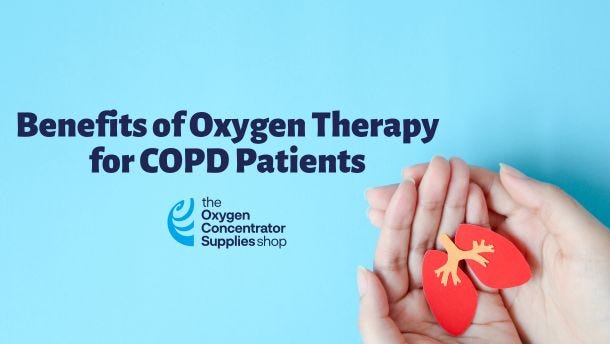COPD, or chronic obstructive pulmonary disease, is a respiratory illness that causes inflammation of the lungs which can obstruct airflow. It is a progressive, long-term disease, and according to the National Heart, Lung, and Blood Institute, it affects 16 million Americans. Oxygen therapy is a common treatment for respiratory illness as it increases the amount of oxygen in the lungs and bloodstream. Let's take a look at how oxygen therapy may benefit COPD.


What is Oxygen Therapy?
Oxygen therapy provides supplemental oxygen as medical treatment to those who need more oxygen than just breathing. It can be used for those who have lung diseases, breathing problems, or other respiratory illnesses to help their bodies properly function. The supplemental oxygen given during oxygen therapy helps people breathe better, improves oxygen blood levels, and more.
Who Needs Oxygen Therapy?
Those who are more likely to need oxygen therapy are:
- Patients with low oxygen blood levels
- Patients who can't get enough oxygen on their own
- Those who have COPD, pneumonia, and other respiratory illnesses
How Does Oxygen Therapy Help COPD?
Airflow in COPD patients can become limited due to increased mucus production and inflamed airways. Because COPD reduces oxygen levels, you may feel tired and short of breath. Long-term oxygen therapy helps minimize the debilitating symptoms of COPD including fatigue, wheezing, coughing and difficulty breathing. Oxygen therapy may also help patients avoid severe health consequences of the disease, including the risk of heart failure.
Although there are some common myths that deter patients from seeking oxygen therapy, this supplemental treatment is most often beneficial. However, it’s best to discuss the potential for oxygen therapy as a treatment for COPD with your doctor.
How Does Oxygen Therapy Work?
When patients have been prescribed oxygen therapy doctors and nurses often recommend supplemental oxygen. There are many ways that supplemental oxygen can be given:
Nasal Cannulas - a plastic tube connects the oxygen to two small cannulas that fit into the nostrils.
Face Masks - these cover both the nose and mouth and are often used by those who have more difficulty breathing oxygen and need much more oxygen.
Transtracheal Therapy or Surgery - in this therapy a small hole is created in the windpipe. Through that hole, a tube is attached and connected with the oxygen concentrator to improve the flow of oxygen directly to the lungs.
Oxygen Concentrators - these are small oxygen generation machines that are portable and powered by batteries, or connect to an outlet for a home oxygen concentrator.
When Should Oxygen Therapy be Used for COPD?
Oxygen therapy should only be used for treating COPD after receiving a prescription from your doctor. The prescribed amount of oxygen varies depending on the patient. Too much oxygen in the bloodstream can lead to oxygen toxicity.
Many COPD patients still lead active lifestyles. If physical exertion causes oxygen levels to drop too low, however, they may require oxygen therapy while working out. Similarly, sleeping naturally causes breathing to slow. Patients with more severe cases of COPD may need oxygen therapy while sleeping. For these circumstances, we recommend keeping a home oxygen concentrator by the bedside.
Air travel may exacerbate COPD symptoms due to the rapid shift in elevation while flying. If you have COPD and plan to travel you should learn more about our FAA-approved portable oxygen concentrators.
What are Healthy Oxygen Levels?
For most people, a healthy oxygen level should range from 95-100%. However, if a person has a lung disease, like COPD, their levels will be lower. Although a healthcare provider can check your oxygen levels, using a pulse oximeter could also determine it as well.
Do I Need Oxygen Therapy for my COPD?
Feelings of breathlessness do not indicate that a patient is not getting enough oxygen. Therefore, not all COPD patients are prescribed oxygen therapy. Blood tests such as pulse oximetry tests can determine if oxygen levels are too low and if therapy is required.
How Do I Get Oxygen Therapy?
You must receive a prescription from a physician to receive oxygen therapy. Two of the most common ways oxygen therapy is provided is through oxygen tanks or oxygen concentrators. Many COPD patients prefer oxygen concentrators for their portability, safety, and convenience.
Benfits of Oxygen Therapy
There are many benefits of oxygen therpay, including improving the following health conditions:
Acute Lung Failure
Acute lung failure occurs when a person's lungs can't release enough oxygen into their bloodstream, resulting in their organs not functioning properly. With the use of oxygen therapy, a person can have better upper airways to breathe, improved lung function, and reduced pressure on the lungs.
COPD
COPD is a group of lung diseases that may require the use of supplemental oxygen. Oxygen therapy can improve the overall quality of life of a person with COPD, as well as reduce their anxiety, reduce pressure on the heart blood vessels, improve their sleeping habits, and more.
Cystic Fibrosis
Cystic fibrosis is a genetic disease that affects the lungs and gives those who suffer from it breathing problems. The use of oxygen therapy can improve their breathing and their sleep quality, and increase their blood oxygen levels.
Asthma
Asthma is a respiratory illness that causes spasms in the lungs, making it hard to breathe. Oxygen therapy can decrease their episodes of shortness of breath. Additionally, those who have asthma and use oxygen therapy can also gain an increase in energy.
Benefits of Oxygen Concentrators for COPD
- Oxygen concentrators are safer than oxygen tanks. Oxygen tanks store compressed air that can leak. Compressed air is highly flammable, so a leak increases the risk of fire, but you never have to face these safety hazards with an oxygen concentrator.
- Oxygen concentrators provide a consistent oxygen supply. Oxygen tanks only provide a limited amount of oxygen before needing replacement. On the other hand, oxygen concentrators never run out as they are continuously filtering air from the environment to provide therapy.
- Oxygen concentrators are compact and portable. Oxygen concentrators come in two options – home concentrators and portable concentrators. Most oxygen concentrators are much smaller than oxygen tanks, and the portable options are convenient for travel.
Is Oxygen Therapy Safe?
Oxygen therapy is safe to use as some people may be prescribed to use it 24/7. However, although oxygen is safe, it can cause a fire which could lead to dangerous situations. To protect everyone's safety, there are some precautions patients can take when using oxygen therapy:
- Do not smoke while using an oxygen concentrator or while near one.
- Stay at least 5 feet away from an open flame, including stoves, candles, fireplaces, and others.
- Try not to use oxygen therapy in an enclosed space.
- Do not use materials like aerosol sprays, cleaning materials, and other flammable materials when using oxygen therapy.
- Ensure all smoke alarms in the household are working properly.
- Have a fire extinguisher nearby in case of emergencies.
Choosing an Oxygen Concentrator for COPD
Have you been diagnosed with COPD and prescribed oxygen therapy? Our experts can provide you with consultation on the safe, practical benefits of oxygen concentrators. Reach our knowledgeable customer service team by phone at 888-941-1688 or via email at contact@oxygenconcentratorsupplies.com. We can answer all your questions or help you pick out an oxygen concentrator that best fits your needs.



